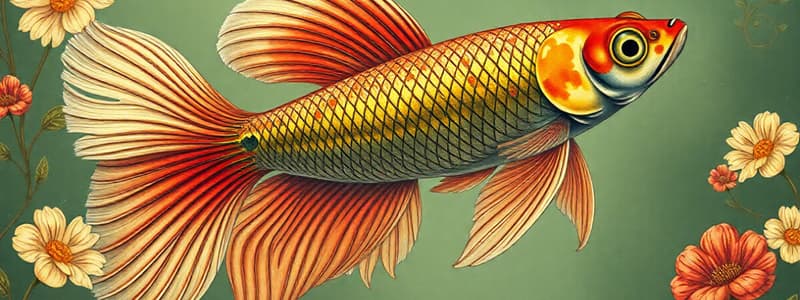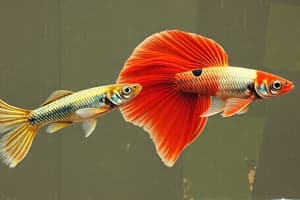Podcast
Questions and Answers
In Endler's guppy experiments, what two opposing selection pressures influence the evolution of male guppy coloration?
In Endler's guppy experiments, what two opposing selection pressures influence the evolution of male guppy coloration?
- Mutation rates and genetic drift affecting color variation independent of selection
- Competition for resources favoring specific colors and environmental conditions
- Natural selection favoring larger size and sexual selection favoring smaller size
- Predation favoring duller colors and sexual selection favoring brighter colors (correct)
In lab experiments with guppies and predators, the gravel size at the bottom of the tank had no impact on the guppies' evolved camouflage coloration.
In lab experiments with guppies and predators, the gravel size at the bottom of the tank had no impact on the guppies' evolved camouflage coloration.
False (B)
What observation was made about guppy coloration in streams with predators versus streams without predators during the field experiments?
What observation was made about guppy coloration in streams with predators versus streams without predators during the field experiments?
Guppies in streams with predators remained dull in color, while those in streams without predators become more colorful.
In conditions with no predators, guppies evolve coloration that best ______ females.
In conditions with no predators, guppies evolve coloration that best ______ females.
Match the experimental conditions with the evolutionary outcome observed in Endler's guppy experiments.
Match the experimental conditions with the evolutionary outcome observed in Endler's guppy experiments.
Which of the following statements best describes the relationship between natural selection and evolution?
Which of the following statements best describes the relationship between natural selection and evolution?
Traits acquired during an organism's lifetime, such as increased muscle mass from exercise, can be directly passed on to its offspring through natural selection.
Traits acquired during an organism's lifetime, such as increased muscle mass from exercise, can be directly passed on to its offspring through natural selection.
Explain how genetic variation is essential for natural selection to occur within a population.
Explain how genetic variation is essential for natural selection to occur within a population.
The ability of an organism to survive and reproduce successfully in its environment is referred to as its ______.
The ability of an organism to survive and reproduce successfully in its environment is referred to as its ______.
Which of the following is NOT a cause of genetic variation within a population?
Which of the following is NOT a cause of genetic variation within a population?
Overproduction of offspring always guarantees the survival of a species.
Overproduction of offspring always guarantees the survival of a species.
Briefly explain how sexual selection can lead to the evolution of traits that may not directly enhance survival.
Briefly explain how sexual selection can lead to the evolution of traits that may not directly enhance survival.
Match each process with its role in natural selection:
Match each process with its role in natural selection:
Flashcards
Natural Selection
Natural Selection
Organisms with traits better suited to their environment tend to survive and reproduce.
Fitness
Fitness
How well an organism is adapted to its environment, influencing its survival and reproduction.
Genetic Variation
Genetic Variation
Differences in alleles (gene versions) within a species.
Sources of Genetic Variation
Sources of Genetic Variation
Signup and view all the flashcards
Overproduction of Offspring
Overproduction of Offspring
Signup and view all the flashcards
Selection Pressures
Selection Pressures
Signup and view all the flashcards
Differential Survival and Reproduction
Differential Survival and Reproduction
Signup and view all the flashcards
Sexual Selection
Sexual Selection
Signup and view all the flashcards
Advantageous Adaptation
Advantageous Adaptation
Signup and view all the flashcards
Sexual Selection (Guppies)
Sexual Selection (Guppies)
Signup and view all the flashcards
Color Trade-off (Guppies)
Color Trade-off (Guppies)
Signup and view all the flashcards
Guppy Color (No Predators)
Guppy Color (No Predators)
Signup and view all the flashcards
Guppy Color (With Predators)
Guppy Color (With Predators)
Signup and view all the flashcards
Study Notes
- Natural selection favors organisms better adapted to their abiotic environment, increasing their survival and reproduction rates.
- This process allows species to evolve over billions of years, contributing to Earth's biodiversity.
- Natural selection is only one mechanism of evolution, not evolution itself.
Fitness
- Fitness describes how well an organism is adapted to its environment, often referred to as "survival of the fittest."
- The most advantageous traits for survival depend on the specific environment.
The Process of Natural Selection
Genetic Variation
- Genetic variation refers to differences in alleles within a species.
- Variation is essential for natural selection, as there must be advantageous and disadvantageous traits.
- Genetic variation is caused by:
- Mutations: Changes in genes create new alleles.
- Meiosis: Crossing over, random orientation, and independent assortment of chromosomes.
- Reproduction: The combination of unique sperm and egg.
- Natural selection affects heritable traits, not acquired traits.
Overproduction of Offspring
- Organisms tend to produce more offspring than the ecosystem can support.
- Density-dependent limiting factors, like food availability, create competition.
Selection Pressures
- Abiotic factors determine the range of tolerance for organisms to survive and reproduce.
- Organisms are adapted to their specific niche or range of tolerance.
- Advantageous adaptations increase the likelihood of survival and reproduction.
- Disadvantageous adaptations decrease the likelihood of survival and reproduction.
Differential Survival and Reproduction
- Individuals that are more fit are more likely to survive and reproduce.
- Competition can lead to competitive exclusion, where better-adapted organisms outcompete or force others to change their niche.
- Advantageous adaptations become more common over time.
- Disadvantageous adaptations become less common over time.
- This leads to evolution and potentially speciation.
Sexual Selection
- Sexual selection can also act as a selection pressure.
- Preferences for specific traits in one sex can drive the prevalence of those traits.
- More advantageous traits increase the chance of survival and reproduction.
- Examples include color, size, and courtship behaviors.
Endler's Guppies
- Color in guppies is subject to two conflicting selection pressures: sexual selection (female preference) favoring brighter colors and predation selecting against bright colors.
Lab Experiments
- Guppies were placed in tanks with or without predators, and with either fine or coarse gravel at the bottom.
- In the presence of predators, guppies evolved colors that best camouflaged them against their habitat.
- In the absence of predators, guppies evolved colors that were most attractive to females.
Field Experiments
- Wild guppies in streams with predators remained dull in color.
- Guppies in streams without predators evolved brighter colors.
Studying That Suits You
Use AI to generate personalized quizzes and flashcards to suit your learning preferences.


